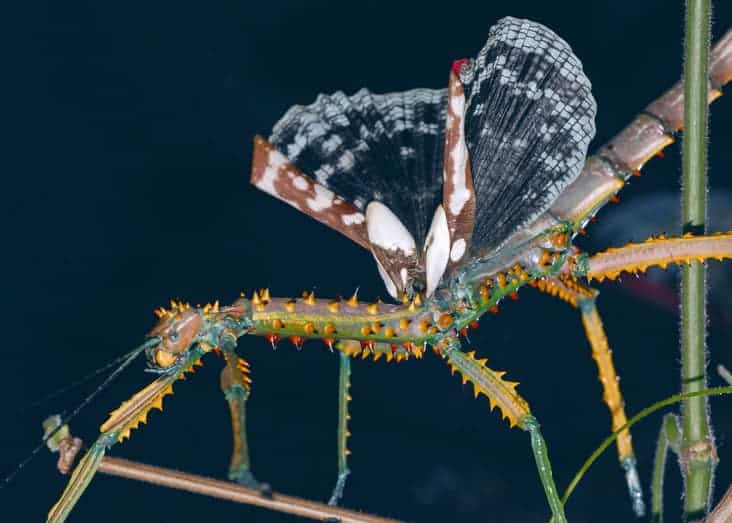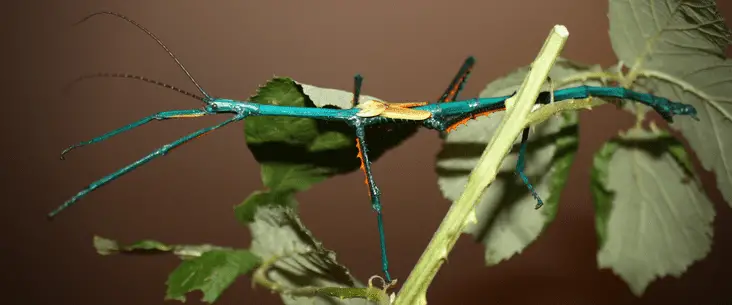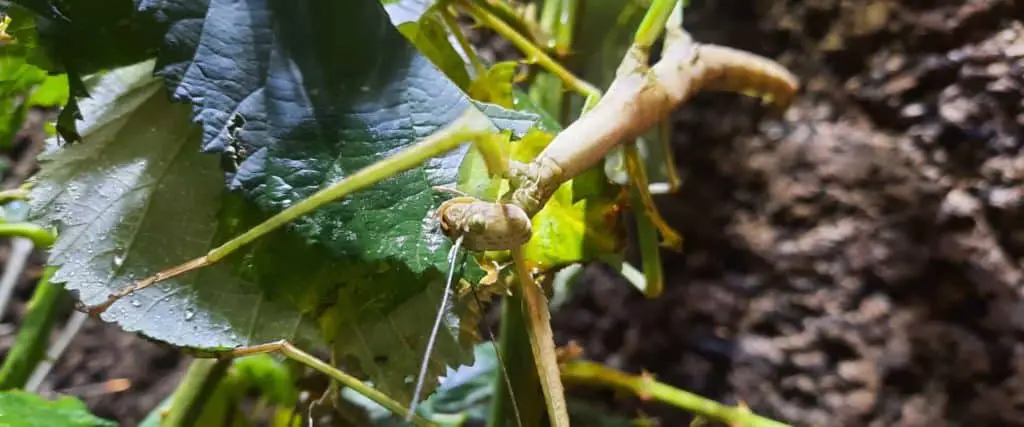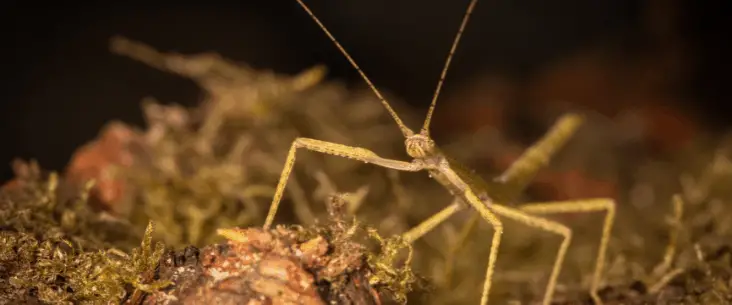There are so many different stick insect species you can keep as a pet. One is even more colourful or strangely shaped than the other. So it can be sometimes difficult to choose which one you should keep at home. But do you need to choose? Can you keep different stick insect species together? This article looks at the possibilities and challenges of keeping different species of stick insects together in one habitat.
Several combinations of stick insect species are suitable to be kept together. The species must have the same housing and environmental needs. There are bulkier or pinching stick insects that will harm each other when housed with other species. Leaf insects, together with stick insects, are not a good combination.
But what are the challenges, the possibilities and the risks? Read on for more about this and some practical tips to think about when you wish to keep different species together.
New to keeping stick insects?
Are you new to keeping stick insects or leaf insects? It would be better to start with a single stick insect species and build some experience first. After a while, you can try to keep different species together. Check out our basics guide on caring for stick insects.
Keeping different stick insects together — Should you do it?
That you can keep different stick insects together does not mean you should just immediately place them together. Not every combination is successful, and some combinations guarantee that one or both will suffer from it. And even if other keepers have proven that a certain combination is possible, you still need to be aware of a couple of practicalities. There are some things to think about. What are the challenges (or risks) if you want to place different species together?
Challenges of keeping different stick insects together?
The first important thing you need to consider is the needs of both species. They need to be rather the same to make them be kept together successful. So both must need the same temperature range and the same humidity range. Otherwise, one of the species (or even both) will be kept suboptimal.
Secondly, you need larger housing. Don’t use the measurements for minimal housing sizes but go bigger. But what size enclosure should you take? I recommend to take the minimal housing size of the biggest species of the two, and double it! The larger, the better. This way, both species can find their own space to rest and feed. Obviously, the more animals you wish to keep the more space you need.
Although you would think it makes it easy that they feed on the same food plant, it can also be easy that they both have their own preference. If each species have its own food preference, there is less competition between the two. But, if they prefer the same food plant, it is fine as well. But make sure that you feed enough, and that food is available all the time.
Be careful with combining bulkier or thorny stick insects with smaller (and often more fragile) stick insects. The bulky animals are sometimes clumsy and could damage your smaller stick insects. It is the same with thorny stick insects (yes, they have those thorns for a reason). Besides that, some bulkier/thorny stick insects can be more aggressive in their behaviour.
Not such a big problem, but sometimes it isn’t easy to separate which eggs belong to which species. It can make it more difficult to breed. Also, it would be best practice to keep stick insect species that have the same breeding strategy. If you have a stick insect that glues the eggs on leaves, and another stick insect eats those leaves, you probably can guess where it ends, right?
It is wonderful to experiment with combining stick insect species when you consider the notes above. But a quick tip here: have an enclosure ready when the combination fails, and you need to house them separately.
Can you keep stick insects and leaf insects together?
The simple answer is no. Although there is an anecdotal case it worked, generally this combination is deemed to fail. It doesn’t work because of the one thing that normally safes a stick insects life: camouflage.
The stick insects will eat the leaf insects alive. Especially when food availability is scarce, but even with enough food, an occasional bite from the leaf insect is inevitable. Besides that, leaf insects are quite delicate and have higher/narrower environment requirements.
So, it is best to keep leaf insect species in a single setup without other species. Never tried to keep different leaf insect species together, but because they are so delicate and fragile, I rather keep them in a single species only set up.
How many stick insects can live together?
It is difficult to determine how many stick insects can live together. It depends on multiple factors such as available space and the size of the species. I have never tried it myself, but I’ve seen reports that keepers house up to 5 different species together — often only keep one male and one female of each species.
The more species you keep, the more space you require. For example, I take care of ~60 Pharnacia ponderosa in an enclosure that is 150cm (60″) in height and has a surface of 70cm x 70cm (27.5″ x 27.5″).
If you start with combining different species, I recommend starting with only two different species. And don’t keep too many individuals of each species. Only 2 to 4 individuals of each species is a good way to build up experience for communal setups.

Stick insect combinations known to be successful
In the list below are stick insect combination that has been proven to be successful. This is (probably) a fraction of the combinations that can be successful.
- Carausius morosus and many others (is easy to combine)
- Aretaon Asperrimus and Spinoherosea Bengalensis
- Peruphasma schultei and Spinoherosea Bengalensis
- Peruphasma schultei and Aretaon Asperrimus
- Lamponius guerini and Carausius morosus
- Podacanthus typhon and Carausius morosus
Disclaimer: This combination only works with enough food, space and that for all species, the temperature/humidity requirements are met. It is not a guarantee these combinations will also work for you!
Want to have high success with breeding? Don’t place different species together.
If you like to have high success breeding with one or both of the species? Then it is better to house them separately. Different species increase the risk of lower hatching and survival rate. Want to know more about increasing the hatching and survival rate of nymphs? Check out this article about keeping nymphs alive or our stick insect breeding guide.
Will stick insects eat or fight each other?
Generally, stick insects are calm creatures that only mind their own business. They sit still on a branch or leaf during daylight or wave pretending a swinging stick in the wind. So, would stick insects eat or fight each other?
Stick insects are not territorial and not particularly aggressive or defensive. They normally won’t attack or fight for food, space or mates. This makes stick insects such good pets. And that combining species is in many circumstances doable.
However, it is known that stick insects that are bulkier are rather clumsy in their movement. During this clumsiness, they can damage more fragile and smaller species when you combine them. Some heavier stick insects are also more aggressive present — which means that if they want that leaf to feed on, they will feed on it, no matter if there is another animal in the way.
Stick insects are primarily herbivorous: they only will feed on plant material. They won’t perform cannibalism like is seen in praying mantis. But, when food is scarce they can start nibble on well-camouflaged species (often starting with the legs). This is especially seen with stick insects combined with leaf insects but is observed between two different stick insects as well.
Can stick insects live alone — or do they need company?
Is it sad if you keep a stick insect alone, or can be kept alone without a problem? Stick insects don’t necessarily need company. As far as we know, they don’t need social interaction to have better welfare or feel safe when they are with more individuals. The only reason when you don’t want to keep them alone is to breed with them.
Stick insects in nature often have a lonely existence. To my knowledge, there are no species that live specifically in groups. At least I’ve never seen a report that they do. So there is also no social suffering when you keep them alone.
So you can perfectly house a single stick insect in an enclosure, and therefore you can also combine two individuals from different species together. It can be even the best way to start when you want to combine two species (also to experiment with combining two species). The benefit is that you don’t need such a large enclosure. Females of many species can even lay fertile eggs without the need for a male (parthenogenesis).

Can you keep stick insects with other (insect) species?
We discussed that different stick insects could be housed together without noteworthy problems if you consider the species’ basic requirements and provide enough space. But how about combining them with other species than stick insects?
Of course, all carnivorous or omnivorous animals can’t be housed with stick insects without having trouble. For example, if you keep a praying mantis together with a stick insect will not be successful (at least not for the stick insect). But some other species can be housed together with stick insects.
One of the species that works really well with stick insects is giant millipedes. First, millipedes are detritivorous, which mean they eat on decaying organic matter. So there is not a food competition between the two. Secondly, most millipedes are ground-dwellers living on the substrate floor, although some occasionally stretch a leg in a climb on branches. But they won’t be much in each other way.
Other species that also have been successfully combined with stick insects are cockroaches. It is a bit the same as with millipedes. They live on the forest floor and feed mostly on (decaying) fruits and vegetables. Some nice Madagascar hissing cockroaches are nice to combine with stick insects. Isopods can also be combined successfully with stick insects in one enclosure. As for requirements, they are pretty the same as cockroaches but have much fewer space requirements.
As with combining any species, you must fulfil both species’ needs to make it a success. This means enough space, no food competition, and relatively the same temperature and humidity needs. Species that work well are species that live in another level of the enclosure. Therefore, combining ground-dwelling species with stick insects works really well. But you’ll need to accept that occasionally a stick insects may be lost and eaten. When one stick insect falls on the floor, and can’t get above soon enough, it may get eaten by a cockroach or millipede.
Species that are not suitable to combine with stick insects include:
- Praying mantises
- Centipedes
- Larger slugs and snails
- Carnivorous beetles (some herbivorous flower beetles will work)
Much more to learn!
There is much more to learn about stick insects. For example, do stick insects need a substrate? You can find more articles about stick insects with plenty of practical tips to better understand and enjoy the keeping of stick insects as a pet.
Share this page!



